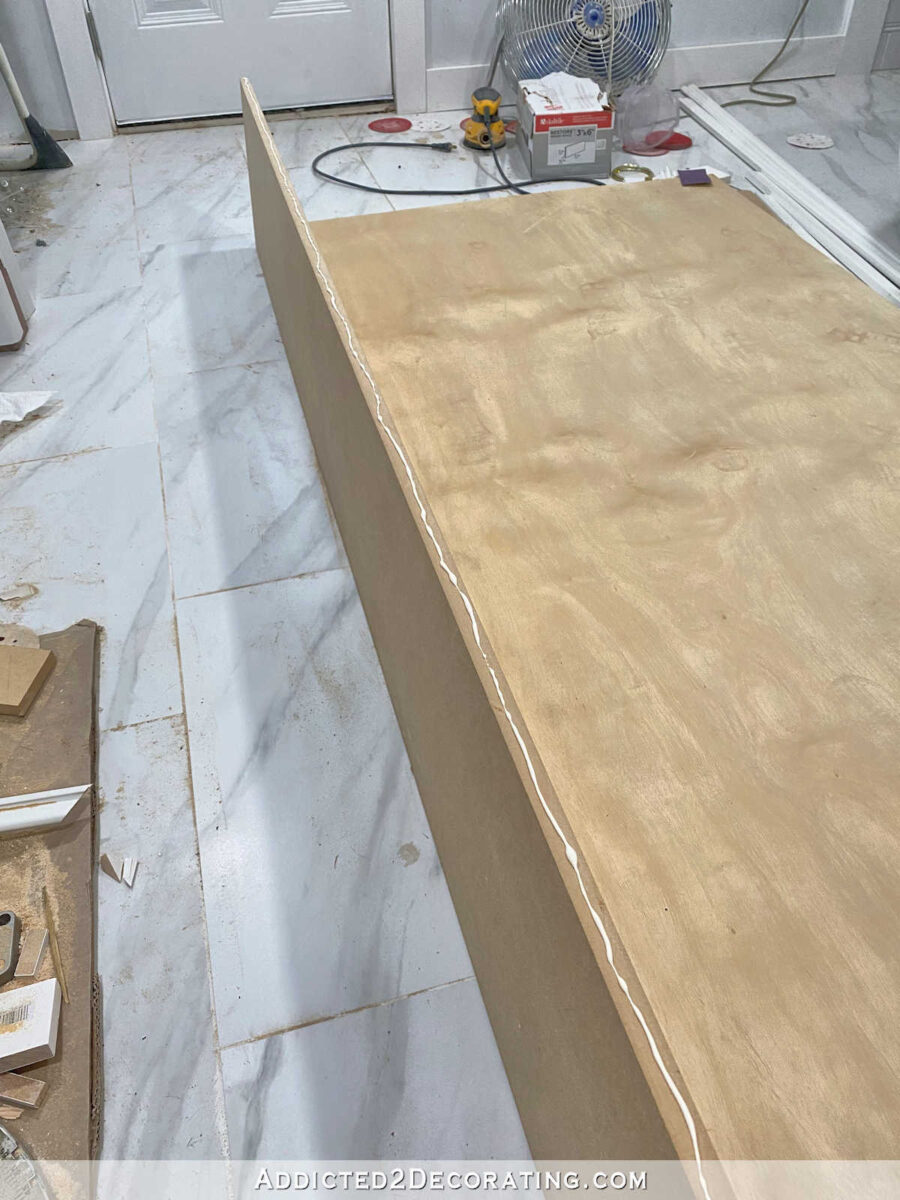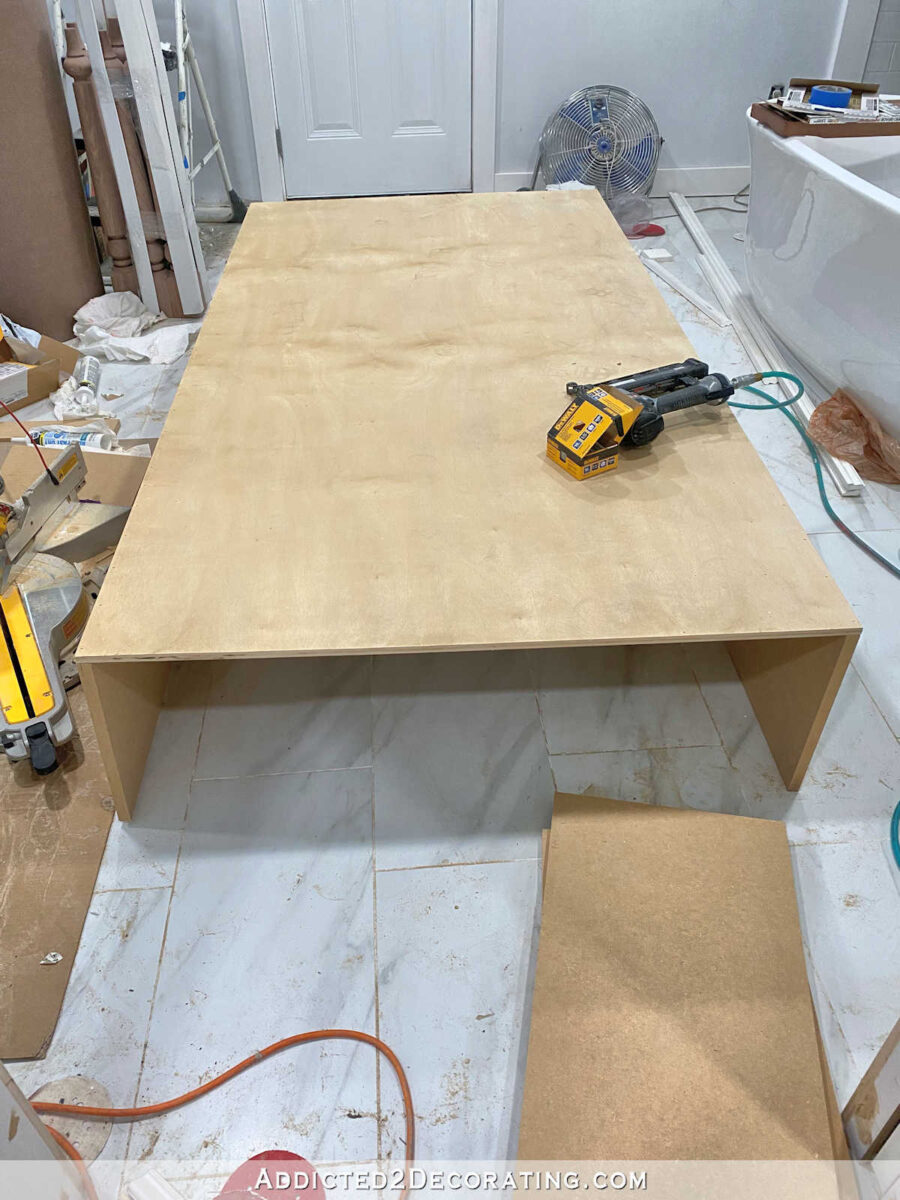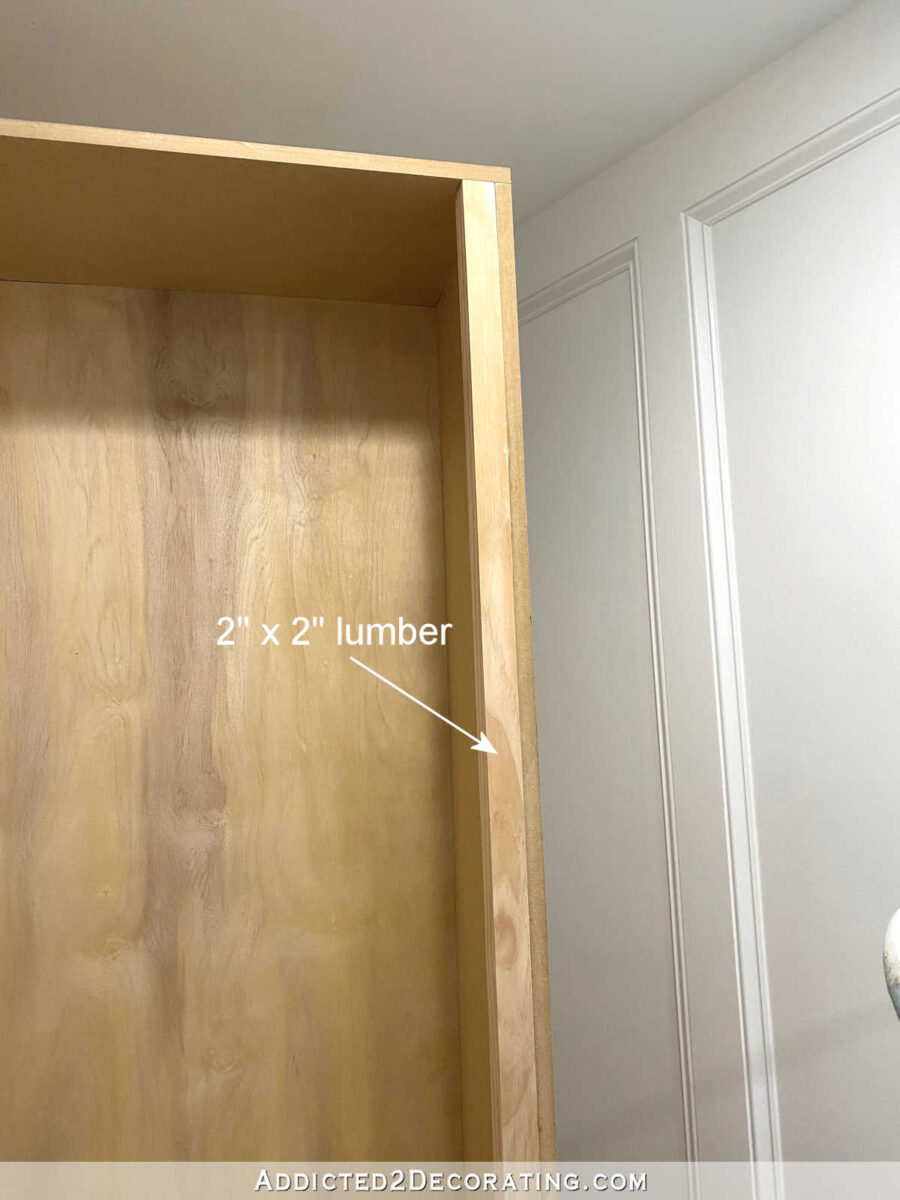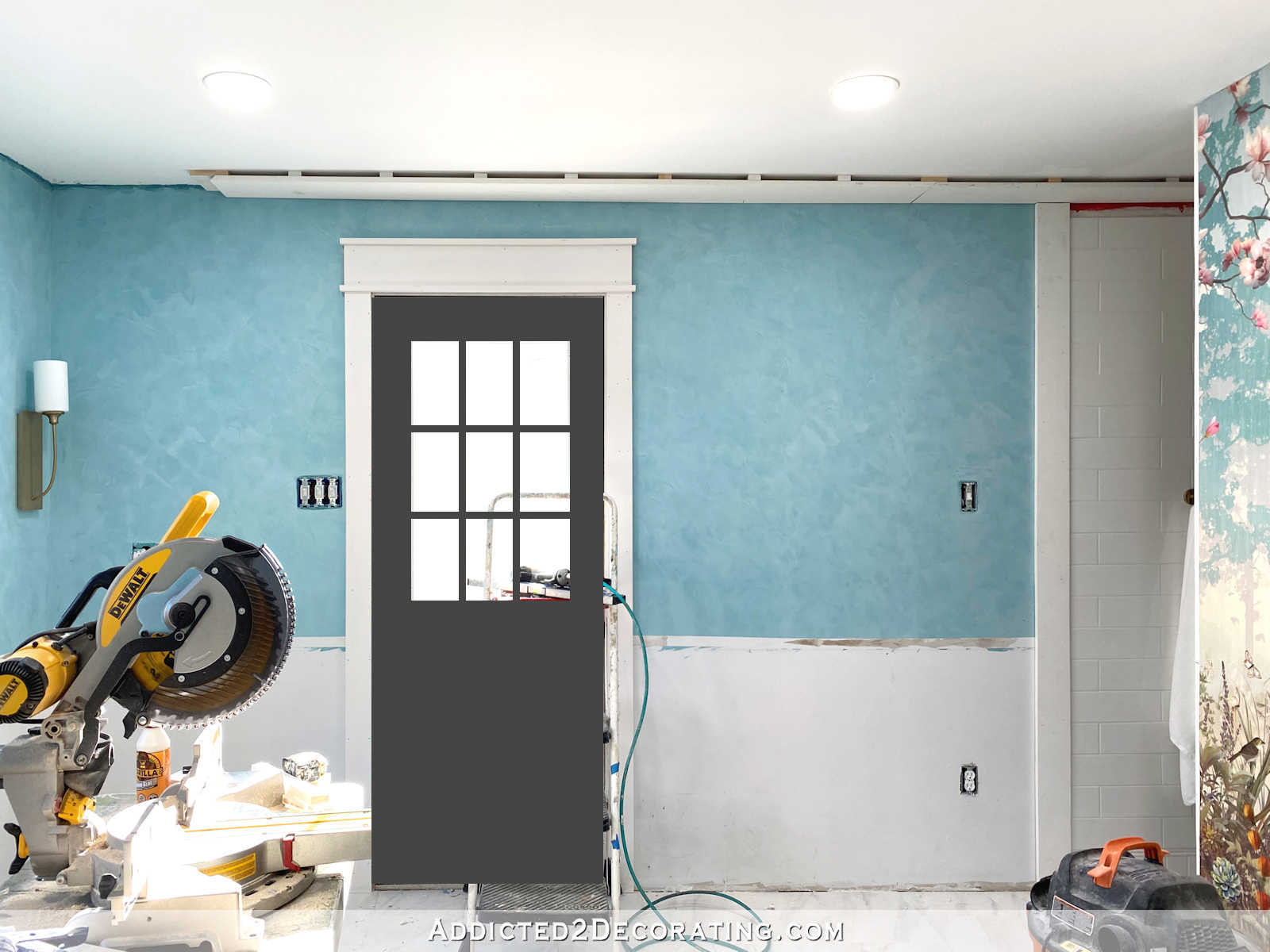DIY: How To Build A Storage Cabinet With French Doors (Part 1 — The Basic Build)
Have you ever wondered how to build a storage cabinet using leftover French doors? Okay, probably not. 😀 But I happened to have some unused French doors on hand that I removed from our pantry, and I kept them because I was certain I could find a use for them.
So when I decided that the water closet area of our master bathroom had room for lots of storage, I decided to build a large storage cabinet with French doors. Here’s what the French doors looked like when they were on the pantry…

And here’s what they look like on the very basic build of the new DIY bathroom storage cabinet. This cabinet is far from finished, but this is the progress…

Before I even started building the cabinet, I first used my circular saw to cut down the doors. You’ll notice in the pictures above that when the doors were used as regular interior doors on the pantry, the top and bottom rails were wider than the side stiles. But when used as cabinet doors, the rails and stiles should be the same width. So once I got those cut down, then I was ready to use these doors and their measurements as a jumping off point for the rest of the build.
That cabinet still needs a whole lot of trim, maybe even some cute little feet, and shelves inside. Then I can paint and prime it. But all of that will be fairly easy, especially compared to the main part of this build. I’ve never built a cabinet this large that wasn’t built-in, and I’ve found that building built-in cabinets is a whole lot easier.
Building a large freestanding cabinet isn’t necessarily difficult, but finding the work space for it is a challenge. And since I work alone, and there’s no way I can carry such a huge cabinet once it’s built, I had to so all of the building in the bathroom, with about half of it being done inside the small water closet. That was quite a challenge! 😀 But I was determined, and I got it done. Now I can move on the fun part — the trim and the finishing.
How to build a large storage cabinet with French doors:
1. Cut the main pieces
To cut these pieces, I used my circular saw along with a Kreg Circular Saw Guide (affiliate link). The first step was to cut the back piece out of 1/2-inch plywood. All of my measurements were based on the doors I wanted to use. The width of the two doors together was 36 inches, and the height was 70 inches. So I added 7 inches to that width (3.5 inches for each side) and 13 inches to the height (7.25 for the bottom and 5.75 for the top — numbers I pulled right out of thin air because I thought they would look nice). So I cut the back piece to 43 inches wide and 83 inches tall. Again, this was all based around the measurement of the doors, which were my starting point.

And then I cut the two side pieces to 13.5 inches wide by 83 inches high, and two top and bottom pieces to 14 inches wide and 43 inches long. I cut these out of MDF simply because I had some large scrap pieces of MDF on hand, so I saved about $70 by not having to purchase a piece of plywood for these pieces.

So once I had my main pieces cut, I started with the two side pieces…

And the back piece….

2. Attach the back to the sides
Standing one of the side pieces up on edge, I placed a bead of wood glue along the long edge…

And then I lifted the plywood back up on to that edge, made sure they were aligned, and then attached them using 1.5-inch 16-gauge nails in my nail gun. I didn’t use screws because I don’t like screwing into the edge of MDF. As long as I’m using wood glue and nailing the pieces about every 4-6 inches, I completely trust 16-gauge nails to do the job.

Then I moved to the other side and attached the second side. That gave me the start of the main cabinet box…

3. Attach the top and bottom pieces
Next I attached the top and the bottom pieces, which were the final pieces of the main box. The pieces were 14 inches wide (the width of the side pieces + the thickness of the plywood back) and 43 inches long (the same as the plywood back). I attached these pieces also using wood glue and 16-gauge nails, and I used one on the top and one on the bottom.

At this point, I stood the box upright and moved it into its location, where I’d have to finish the build. Again, since I work alone, and there’s no way I could have built this outside and then moved it in by myself, I had to do everything in place so that I could just slide it where it needed to go.

4. Attach the stiles
Since I was using actual wood interior doors for the cabinet doors (which are thicker and heavier than actual cabinet doors), I wanted to add more support and strength to the sides where the doors would be attached before I started adding the stiles and rails to the cabinet box.
I added this strength and support by gluing and nailing 2″ x 2″ pine lumber on the inside of the box. I attached these using wood glue and 16-gauge nails, nailing it from the outside of the box through the MDF and into the pine lumber, making sure that the front edges of the lumber and the MDF were perfectly flush.

Here’s a closer view after the first one was attached. And again, the purpose of this was to add strength. I didn’t want to attach a heavy wood and glass door to a stile that was only attached to the edge of MDF. This gave me 1.5 inches of real, solid wood to attach the side stiles to.

For the stiles, I used 1″ x 4″ pre-primed fingerjoint boards (which are actually 3.5 inches wide), and using wood glue and 16-gauge nails, I attached those to the 2″ x 2″ pine boards that I had just attached.

I actually doubled up those side stiles, using two 1″ x 4″ boards stacked on each other and attached one at a time, to make the stiles thicker. This was only necessary because I was using actual interior doors as my cabinet doors, and I was planning on installing the doors so that they were inset. Since the doors are 1.5 inches thick, I wanted my stiles to also be 1.5 inches thick. Had I been using regular cabinet doors, which are generally only 3/4-inch thick, doubling up the stiles would have been completely unnecessary.

I repeated that whole process on the other side of the cabinet box so that both the left and the right stile were attached before moving on to the next step.
5. Attach the bottom rail
Next, I attached the bottom rail. After measuring the space between the stiles and verifying that it was 36 inches, I cut the bottom rail out of 1″ x 8″ pre-primed fingerjoint boards. I doubled up the thickness on this piece as well so that it would match the thickness of the stiles, and then I used my Kreg Pocket Hole Jig to drill pocket holes in each end of the rail.

By the way, this is the Kreg Pocket Hole Jig (affiliate link) that I have, and it is AWESOME!! It’s an amazing upgrade from the original one that I bought. I think this style is a fairly recent product, and I highly recommend it.
I put the bottom rail in place, checking for square and holding it into position using two clamps (Tip: You can use the 45-degree angle clamps as regular clamps as long as you use scraps of wood under the side with the pointy part).

Once I had it lined up just right, I screwed it into place using the pocket holes I had just drilled into this piece.

Once it was attached, I checked for square one last time to be sure it didn’t shift when I was screwing the piece in place.

And here’s what it looked like at this point — a very simple five-sided box with three of the four front edges covered with trim pieces.

6. Install the doors
On a normal sized cabinet with normal doors, I would have installed the top rail next. But since everything on this is so big and heavy, I decided to install the doors first, and then install the top rail after the doors were installed. That just seemed easier in my mind. 🙂
Before lifting one of the doors into place, I needed a spacer to give me about 1/8-inch of space between the bottom rail and the door. I found that two strips of 16-gauge nails were pretty much the perfect spacers. So I taped two strips together…

And then taped those to the bottom rail so that I wouldn’t knock them off while lifting the doors into place.

Then I could lift and set the door right on top of those spacers, and with the hinges already attached to the door, everything was perfectly spaced on the side and the bottom.

With the door sitting in place, I used a pencil to mark the placement of the middle hinge onto the side stile.

And then to install the door, I did the following:
- Move the door out of the way
- Unscrew the center hinge from the door
- Screw the center hinge into place on the side stile using the guide mark I had just made
- Lift the door so that the holes for the center hinge were aligned with the center hinge that was now installed onto the stile (The door had to be in the open position for this, which made this process very tricky since I was working alone. this was tricky working alone. That’s why you don’t see pictures of this process, but it was manageable.)
Once the door was attached to the stile with the center hinge, then I could very easily attach the top and the bottom hinges to the stile. And once I repeated that process on the other door, this is what it looked like…

7. Attach the top rail
I made the top rail in the exact same way that I made the bottom rail, doubling up on the thickness and drilling pocket holes in both ends. The only difference is that since I was using 1″ x 8″ lumber, and I needed the top rail to be 5.75 inches, I had to use my table saw to cut down the width before drilling the pocket holes and installing it.

But I installed it the same way — nail strip spacers taped to the top of the doors, top rail clamped into place, and then screwed into place using the pocket hole screws.
And once that top rail was attached, I had the basic build of the cabinet complete.

I have a whole lot of trim work to do to turn this from a basic box with doors into a pretty cabinet, but that’s the easy, fun, and creative part. Getting the basic build on this beast of a cabinet, and having to do so in such a small work space, was the challenging part. So stay tuned to see how it all turns out! And now that you can actually see a cabinet in this space, what about the color? Stick with white? Go with a very pale pink? I’m personally still undecided on that.
Note: This is a multi-post project. You can find the rest of the projects at the following links: Part 2 — Trimming out the cabinet; and Part 3 — The finished cabinet.
This project was part of our master bathroom project. You can see the finished master bathroom here.
Addicted 2 Decorating is where I share my DIY and decorating journey as I remodel and decorate the 1948 fixer upper that my husband, Matt, and I bought in 2013. Matt has M.S. and is unable to do physical work, so I do the majority of the work on the house by myself. You can learn more about me here.








White on the outside with pink on the interior.
Ohhh, LOVE the “pop” of color on the interior idea!!
I second that! Love seeing color or paper in cabinet interiors.
Jumping on the bandwagon as well! Trim white on the exterior, pink or paper (maybe even part of the mural?) on the interior.
I love that idea!
Kristi I was just wondering what you plan to put into the cabinet ? I would leave the exterior white and maybe match the vanity color or paint it to match the metal hardware. Can you get some baskets to put items you want to hide and leave the glass as is ? Once again you you show us your amazing talent. Thanks for sharing
I like the idea of pink inside and white outside
I think this is a great idea! Especially a very pale pink.
I vote for this – especially if the cabinet isn’t going to be packed solid with stuff and you will be able to appreciate it. A soft shell pink would be a gorgeous interior of a white cabinet.
Kristi:
It looks great. You are so talented! My favorite of your posts are when you build / make something,, especially with wood. And with your details on your construction process, it is truly inspiring!
Keep the cabinet exterior white and paint the interior either a pale pink or a color that compliments both your mural and your Butterfly gallery wall. Youi don’t want it to compete with either of those. They are so beautiful and calming!
Your bathroom is really coming along well! Kudos!!!
I’d say, stain the interior the same as the vanity and paint the outside white. Save the pink (and other accent colors) for items placed inside the cabinet; to coordinate it with the rest of the bathroom.
I really like it as a stand alone cabinet. Great progress and tutorial!
YHWH Bless You : )
Very impressive! And I like the idea of pops of color with items in the cabinet rather than painting the interior of the cabinet. Looking forward to seeing the completed cabinet!
It’s looking great! I would add some feet or something to set it off the floor. Does it cover up that last vertical row of butterflies or it just the picture angle?
And just like that, again you’ve amazed us, creating and building a beautiful stand alone cabinet. Fantastic job! For the interior cabinet color, I think a very pale version of your bathroom teal Venetian plaster wall color would look amazing with the exterior white.
You never fail to impress me. That’s why I’ve been following you for years and years! Another excellent build!!!
I hope things are still progressing with Matt being able to get out occasionally, too. I know from personal experience what a blessing it is for mental health to be able to leave the house when you’re chronically ill. Kudos to both of you for doing hard things, and praying the Lord’s blessings to you both.
We did something very similar to convert a 36″ wide x 12″ deep bookcase into a china cabinet for our dining room. We used some louvered doors that we had on hand, removing the louvers and adding plexiglas for safety. I covered the louver grooves with some simple screen molding. I then painted the whole thing white to match the other trim in the room, but painted the back inside panel a pretty sky blue.
You continue to amaze us, Kristi! That’s beautiful, and I know you’ll make the right choices regarding trim and paint color. I vote for one of your mural colors on the cabinet’s exterior. If you’re going to keep the interior “staged,” I vote for a white inside. But if you’ll have trouble keeping it insta-ready, maybe you’ll want to frost the glass the way you did on your front door.
Nice job! I was also going to suggest painting the cabinet interior with a pop of color. How about the blue you use in the sink area of your bathroom? Partly depends on what you plan to store inside.
You. Are. Amazing.
I’d stay with white. You can bring in color with towels. You are a master!
Agree! I was wondering why the pink when you did not like it on a wall that was barely visible from the doorway into the room…the cabinet is beautiful and at this point does not distract from the mural. However, after following you for years, you never disappoint with your creativity and love of color.
Do you have any of the wallpaper left over ? I think it would look good on the inside back, with white or pale pink cabinet.
It looks beautiful, just as all your projects have been. However, isn’t it too large for the space. Once the toilet is installed will you be able to open the doors?
Wow all I can say is that you are so talented. That cabinet is beautiful. The entire bathroom rocks. Sure wish I could do what you do.
Just an idea, but what if wait till get vanities built, then see if could possibly “match” cabinet to them? That way have 2 uses of “wood” carried thru.
Boom, that’s how it’s done. You make everything look so easy. I vote for pink on the inside and white on the outside.
Kristi, that cabinet is going to look so nice! You have done a great job designing and building it. And once you get the trim added, it will look fantastic! I definitely think feet would also take it up another notch. Oh, and since you asked, I vote to keep it white. 🙂 xo
Another beautiful piece! What hinges did you use for the doors?
I searched and searched for pretty cabinet door hinges and couldn’t find any. So I ended up keeping the hinges I had used when the doors hung on the pantry doorway. They are these non-mortise closet door hinges.
this is the most well described instructions EVER! Thanks
Well done! I can’t wait to see what you do in the way of trim.
I just discovered your blog, and I could read it all day… if I weren’t doing my own similar projects! I sneak it into all the cracks though. Great inspiration! You have so much color! …And the courage to charge in and do EVERYTHING. You are amazing! Thanks for sharing.
Kristi, I hate to rain on your parade but ,I look at the almost finished cabinet and I think it is missing feet or at least a base. The whole cabinet is just sitting flat on the floor of the toilet area. If there is a leak, it is going to be yucky. 🙁 Plus, the bottom and sides are particle board and it will be ruined after it gets wet. I so love how you use so much color, and pretty colors, in your house. 🙂
Hugs, Kara
Check out Part 2 of this cabinet project. 🙂 https://www.addicted2decorating.com/diy-storage-cabinet-with-french-doors-part-2-trimming-out-the-cabinet.html